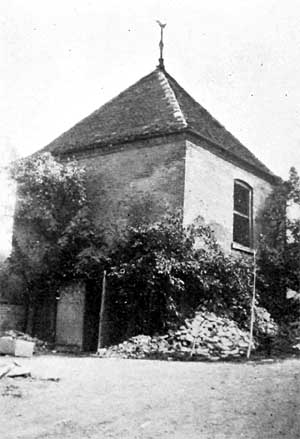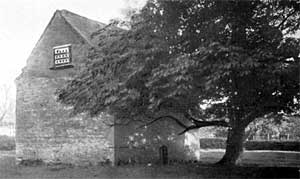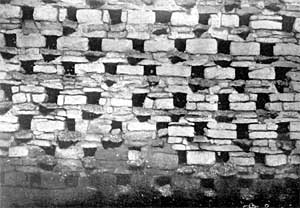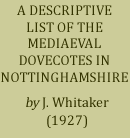THE DOVECOTE AT
EPPERSTONE MANOR.
IT was not till some little time after seeing Major Huskinson’s dovecote that I heard there was a second in the village. I wrote at once to the owner, Mr. Stanley Bourne, who very kindly gave me permission to see it. So on April 19th, I motored over to Epperstone on a bright spring-like day. I found, as we got nearer the village, that hedges and trees were much greener than with us, and the grass and seed fields had much more keep in them. This spring is a late one, especially with the arrival of spring birds. So far, I have not seen a single migrant. During the sixty years that I have been a keen observer of nature, I have always seen one of numerous spring birds before this date. We drove up to the Manor House and Mr. Bourne kindly took me to the dovecote. It stands on the west side of the entrance gate, and was built “Circa,” 1690. It is square in shape, and now covered with ivy. The roof covering has been renewed in late years. On measuring it I found it to be thirteen feet six inches from west to east, and fourteen feet six inches from north to south, the walls being about eighteen feet high to the square. They are of brick, and two feet eight inches thick. The building is now used for storing fruit, and vegetables. The cote, in which the pigeons were, is nine feet above the ground, and is nine feet to the square. There are ten rows of nesting places of nine nests in a row on the north and south walls, and ten rows of eight nests on the east and west walls. I was sorry to see all the entrances to the nests were bricked up. This takes away a great deal of interest from the cote, and as the walls are not used to hang things on, they would not have interfered in any way with its present use. There is a landing ledge, running from wall to wall, under each row of nesting holes. It is just over two inches wide, and the narrowest landing place I have ever seen, but as pigeons for their size have small feet, they don’t require much space to settle on. I was much struck with the two grand oak beams which support the roof. They were only roughly trimmed with the axe, and looked as sound and as good as when they were fixed there over two hundred years ago.
THE DOVECOTE AT HALAM,
NEAR SOUTHWELL.
 HALAM COTE.
HALAM COTE.ON April 23rd, I went to see the dovecote at Halam. It blew half a gale from the north-west, and great masses of dark clouds were drifting overhead, and the wind was bitter cold. I arrived at Halam near on twelve by the clock. It is a quiet village, lying in a vale of rich land, through which the Greet wanders. This capital trout stream rises in the hills to the south-west. There are many pretty cottages, with good gardens, a goodly few having orchards, now showing signs of spring, for the hedges were green, and the pear and plum trees were white with bloom. The village is sheltered from the winds, and catches a goodly amount of sun, and it is still a quiet and peaceful spot, even in these days of motors and rush. A short distance from the main road, on the left hand side, stands the Church, a quaint old structure, with a clock in its low tower. This clock has a face much too large for its surroundings. Directly after passing the churchyard, I spotted the dovecote, a tall, square building, standing alone at the end of a large garden. I called at the house and asked permission to see it, which was at once granted, and Mr. Ricketts, the owner, came with me and most kindly helped me to get all particulars. The cote is a large structure, built of bricks, and contains by far the greatest number of nesting places that I have so far seen in this country. I first took the outside measure and found it stood almost four square, for the tape told me it was twenty-seven feet from north to south, and twenty-four feet from east to west, and was about thirty feet high to the square, with a tiled roof, and a weather cock on the top. Here was an entrance place, and there were three other small ones just under the roof on the north, south and east. That on the south is now replaced by a window. On the west side were a pair of doors. These were used when old pigeons were to be caught, when nets were fixed over them. Then the doors were opened and the pigeons were driven out with them, the other openings having previously been closed when it was dark. This way of catching the birds is rare, for in most places they are caught by nets being placed over the principal entrance place, but these doors are a much better plan and do not frighten the birds so much. I now measured the walls and found them to be two feet thick, and from the size of the bricks I should say they were of Tudor date. I much admired the beautiful mason-work of those days. These bricks were beautifully made, as hard as stone, and had mellowed to a charming colour. The old entrance door had been replaced by a larger one in order to get farm implements in, and store other things, for now it is used for such purposes. Inside I at once noticed that a wooden floor had been put in just half-way up the walls in late times after the keeping of pigeons in it had died out. This was done in order to make more room for storing things. There was also a stair of wood made to get up to it. This has, of course, done much to take away the interest of the building, when all the large number of nesting holes could be seen at once, but has added largely to the storing capacity. I found that in each half there were on three walls ten rows of nesting holes of 17 places, and on the other wall twenty rows of twelve nesting places. This was on the side of the double doors, which took up part of this wall, so that altogether there were over twelve hundred nesting places on the four walls. These entrance holes were five and a half inches wide, and six inches high. They went in straight for fifteen inches, and then on the left end was more space for the nest. It is the first cote where I have seen a square nesting end, it is generally an oval one, and all have had the nesting end on the left side. Running along the entrance holes under every row was a landing ledge three inches wide, for the birds to alight on, and the distance between one ledge and the next above it was eleven inches, and between each entrance hole about the same. When outside again I saw there was only one string course, formed of two rows of bricks, standing out from the wall about three inches more for show than use, for it would have been quite impossible for any vermin to have climbed so beautifully built a wall. I need hardly add I was much impressed with this fine and most interesting structure, and I sincerely trust that every care will be taken of it, and that it will never go the way that so many other fine pigeon cotes have, both in Notts and other parts of Great Britain. To-day, May 25th, I have again been to get a photograph of the inside, and on feeling into several holes I now found that the nest holes varied. All on one row had the enlargement on the right side, then on the next row they were all on the left side, and so on, row after row. I also measured the bricks and found they were nine inches long by four inches wide, and two inches and a half thick, and the inside ones were just as smooth and clean as when put in in the long past years. If I were building to-day, and had the chance, I would much rather buy those bricks than modern ones, for they would look better, and wear better than any of the present time ones.
DOVECOTE AT HALAM, NOTTS.
IT stands four square to all the winds that blow,
Now washed by rain storms, now all white with snow;
T’was builded in the far past Tudor times,
Hard by the Church, and echoes with its chimes.
Its walls of brick are well and truly laid,
By masons who to work were not afraid;
Twelve hundred nesting places line its walls,
Inside the cote resounds with cooing calls.
A gentle south wind turns the gilded vane,
So soft you’d think it comes from sunny Spain;
'Tis early morn and with a hurried rush,
The doves pour out and startle wren and thrush.
Off to the stubble fields they straight-way fly,
Which show in silvery light neath sunny sky;
They feed on scattered corn and many seeds,
Cast from the brown pods of obnoxious weeds.
By this they do a great amount of good,
Helping the farmer to provide more food;
Then when the twilight falls they quickly hie,
Back to their cote because the eve is nigh;
And there they bill and coo till soft night falls,
Then sleep their well-earned sleep till daylight calls;
Long may it stand as in these latter days,
With better pens than mine to sing its praise.
THREE BORDER DOVECOTES ON LINCOLNSHIRE SIDE.
THE HADDINGTON COTE.
ON May 7th, owing to the kindness of my old friend, Captain Walter Need, I saw three dovecotes which just lie over the border of Nottinghamshire, all in the county of Lincoln. He most kindly met me at Newark, where I arrived by motor bus, at eleven by the clock. After we made a start I asked him where we found the first one, and he replied at the village of Haddington. I was
astonished at the name, for it is only seldom we find two villages of the same name, which, if we consider, is rather wonderful knowing the many thousands there are in England and Scotland, and amongst the few, Sutton may be perhaps the most common one, but this name is more often qualified by a second name tacked on to it, as Sutton-in-Ashfield, Sutton-Coldfield, and Sutton-on-Trent. But I cannot ever remember having met with a village called after the capital of any shire, which Haddington is. It is a Royal borough, of small size, but very ancient, and is the capital of Haddingtonshire, or East Lothian, a county in the south east of Scotland, celebrated for its fertile soil and for its well-known agricultural productions. The tenants of these lands are the finest farmers to be found in the United Kingdom, or, perhaps I may venture to say, the world. I know it well, for I first, as a small boy, in 1858, went there to school, and year after year I have been since. I caught my first trout in the River Tyne, which flows through it, and is celebrated for its yellow trout, in 1859, and hope to catch others during this summer. Last September I saw one which was taken in the part of the river running through the borough itself, which weighed just over 8½lbs., and a splendid specimen it was. Well, we soon arrived at the Lincolnshire Haddington, which is little more than a mile out of Notts. Directly I got out of the motor I was much struck by a grand witch elm standing on a patch of grass where four roads meet. It was a particularly fine shaped tree and girthed at four feet up just over fifteen feet, and close by it, in a small grass paddock, stood the old dovecote. It was built of stone, and from all appearances was a very old one, the top is tiled, and, like many others. It is nearly square in size, measuring twenty-four feet from north to south, and twenty feet from east to west. The walls are three feet six inches thick, and are about twenty feet up to the square in height. There was only one string course, fairly high up, which stood out about three and a half inches, but above it, on each corner of the walls, was a piece of stone hollowed out and of the shape of a leaf. It was built in the wall and was about three feet below the tiles and hung over about a foot or so, but as a method of preventing vermin getting up the edge of the walls I have never seen these edge protections on the outside of pigeon-cote walls before. The entrance place for the pigeons was on the south roof, and there were two rows of holes, six in each row. The entrance door was five feet high, by three feet wide, this is larger than usual in most of the older cotes, but it was on the side, within twenty yards of two cottages, which looked about the same date, and could be easily seen from them. Inside there were fourteen rows of nesting places in the walls on the east and west walls, and each row had ten nesting places in it, and fourteen rows on the north and south walls, each row having twelve nesting places, making six hundred and sixteen nests. These had entrance holes five inches wide and five and a half high. They went in fourteen inches, and then had a square shaped place at the left side of the passage. So far I have never come across any nesting holes which were enlarged for the nest on the right side of the passage. Under each row was a landing stage of three inches and a half wide.
 BRANT BROUGHTON COTE.
BRANT BROUGHTON COTE.
STONEWORK, INTERIOR OF BRANT BROUGHTON.
I might add that Haddington is a meeting place of the Blankney Hounds, and so is Brant Broughton, the next place where I saw another dovecote. Starting afresh, we bore to the right and soon crossed the Witham, a small river passing through land which my friend said was quite a good partridge country, and it looked it. We turned to the south west and passed through part of the vale, a pretty country of low-lying land, well farmed, and where a good variety of game and wild fowl are found. Plantations of firs are dotted here and there, and the wolds were on our left hand. These beautiful rolling hills run from near the Humber to the south of Grantham, and have on them many nice estates of varied extent. After a run of about eight miles we arrived at the pretty village of Brant Broughton, and, calling at “The Gables,” asked permission to see the dovecote, which was at once kindly given, and Miss Hind, after getting the key, came with us. This dovecote stands in the paddock, hard by the house, and a line of nice chestnuts run from the pretty lawn to the cote. It is a perfect place for one, and both Captain Need and myself were at once much struck with the size and shape of the door, for it was a miniature Church door in appearance. I at once took its dimensions, three feet high and two feet wide. The top was of an oval shape, and the door itself stood well into the wall, which was three feet thick, and of stone. Miss Hind asked why it was so small, and I told her it was to prevent the thieves, if they robbed it, taking in a large basket to put the pigeons in. She was pleased to know this, for she had often wondered why it was so. She had from time to time been asked by people the reason. This cote was just a square in size, and measured twenty three feet each way, and on the south side was a landing place with twelve holes to enter by for the birds. There was no string course, the first cote I have seen to be without one. On one side there were twelve rows of ten boxes. This was on the door side, the south, and on the north side the same number, but on the east and west sides there were thirteen rows of ten boxes, so in all walls there would be five hundred boxes. The roof was tiled, and the woodwork in it of oak, the larger beams being axe-cut, so they were those put in when it was built. The west gable end was brick. Evidently a tree in old days had blown down and knocked part of the wall down, and it was renewed with bricks of early Georgian date. The small window on that side had probably been built up at that time, for the bricks are the same. The entering holes to the nests were six inches wide and six inches high, and went in fourteen inches, but had no larger places at the end for nesting in. Still there would be room enough. A landing strip ran under each row of holes, and varied from three to three and a half inches wide. This was a fair sized cote, beautifully placed, with pretty surroundings, and of a goodly age, I was much pleased to have seen it, and thank Miss Hind for all her kindly trouble.
THE DOVECOTE AT ‘THE GABLES,” BRANT BROUGHTON,
IT stands hard-by a spreading chestnut tree,
The sun throws dappled shadows on its wall;
And all who see it will agree with me,
How charming ’tis to hear the pigeons call,
Coo-Ru, Coo-Ru, these are the mellow notes,
Which pleasing sounds come from a score of throats.
The swallows just arrived from o’er the sea,
Pass by its oaken door on tireless wing,
And fly around beneath the spreading tree,
Within whose boughs at morn the throstles sing.
The men have gone who built this ancient cote,
Dead and forgotten, as the leaves which fall
In golden showers to the ground they float,
Where plovers come and go with plaintive call
The ruddy kine chew cud beneath its walls,
The white fowls pick about amongst the grass.
And from the tall elm tops the black rook calls,
Watching the laughing children as they pass.
Long may it stand for other folk to see,
This grey stone cote hard-by the chestnut tree.
J. WHITAKER.
May, 1927.
I forgot to say that the floor of this cote was about eighteen inches below the level of the ground outside.
